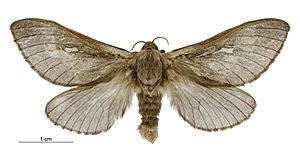Wiseana copularis facts for kids
Quick facts for kids Wiseana copularis |
|
|---|---|
 |
|
| Female specimen | |
 |
|
| Male specimen | |
| Scientific classification | |
| Genus: |
Wiseana
|
| Species: |
copularis
|
| Synonyms | |
|
|
The Wiseana copularis is a type of moth found only in New Zealand. It belongs to a group of moths often called "Porina" moths. These moths look very similar to each other. When they are young (in their larvae stage), they eat grass. If there are too many of them, they can cause problems for farmers by damaging important pastures.
Contents
Meet the Porina Moth!
This moth was first described in 1912 by Edward Meyrick. He called it Porina copularis. Later, in 1961, another scientist named Pierre Viette moved it into the Wiseana group. The main example specimen of this moth is kept at the Natural History Museum, London.
What Does It Look Like?
Male Wiseana copularis moths have a wingspan of about 3.4 to 4 centimeters. Females are a bit bigger, with wingspans from 4.3 to 5.2 centimeters. Their front wings can be dark or light brown. The back wings are usually paler.
It can be tricky to tell this moth apart from other Wiseana species because they look so much alike! One way to identify the male is by looking at its long, rectangular antennae. However, scientists often need to use a microscope to examine the moth closely. They can also use DNA tests to figure out exactly which species it is.
Where Does It Live?
This moth is special because it is endemic to New Zealand. This means it is found naturally nowhere else in the world. You can commonly find it in areas like Wairarapa and Wellington on the North Island. It also lives all over the South Island.
Life Cycle of the Porina Moth
Wiseana copularis moths fly from October to April. They usually start flying just before it gets dark and are attracted to lights. Adult moths only live for a few days.
From Egg to Moth
After mating, a female moth can lay anywhere from 500 to 2,300 eggs in the grass. After about 3 to 5 weeks, the eggs hatch into tiny larvae. These young larvae first eat dead leaves. As they grow bigger, usually between 4 and 15 weeks old, they dig a vertical tunnel in the soil.
At night, the larvae come out of their tunnels to eat grass around the entrance. They hide the tunnel entrance with silk and bits of plants. When they are about 38 weeks old, they become fully grown, reaching up to 7 centimeters long. Then, the moth enters its pupa stage, which lasts about a month. The pupa stays inside the tunnel until it turns into an adult moth.
Surviving in the Wild
Scientists have studied these larvae in labs to learn more about them. They found that larvae survived best at a temperature of 15 degrees Celsius. Young eggs and small larvae are easily harmed by dry weather. They can also be hurt if farm animals walk on them. Once the larvae are safely in their tunnels, they are much better protected from dry conditions. Larvae can also get sick from bacteria. Researchers are looking into using these bacteria to help control the moth population on farms.
Home and Food
Wiseana copularis moths like to live in moist places, such as shrublands and grasslands. The larvae of these moths eat different types of plants. Their favorite foods include Lolium perenne (which is a common type of ryegrass) and Trifolium repens (white clover).
Why Are They Important to Farmers?
The larvae of Wiseana copularis can cause a lot of damage to pastures. This is a big problem for farmers who rely on good grass for their animals. To protect their fields, farmers sometimes use special insect growth regulators. These chemicals, like Diflubenzuron, help to stop the moth larvae from growing and damaging the grass.


